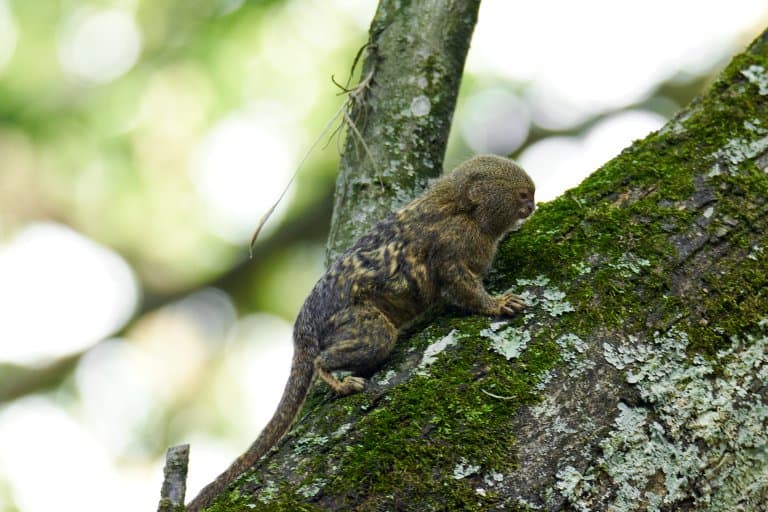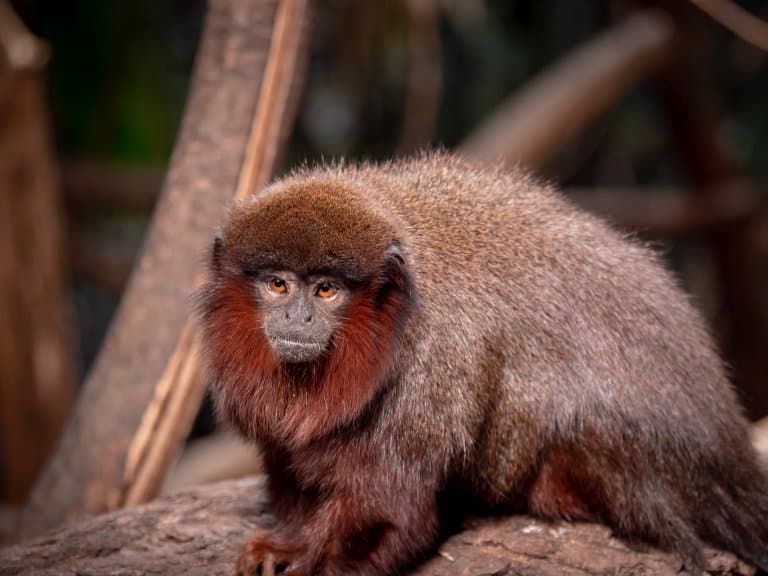Titi Monkey Profile
Titi monkeys come in many shapes and sizes and all are nothing to be ashamed of.
Just make sure you spell them correctly if Googling them at work, and be careful when bringing them up in the Philippines.
Titis comprise a wide range of New World monkey species types across three genera, ranging from undiscovered to critically endangered and all native to South America.

Titi Monkey Facts Overview
| Habitat: | Diverse range of forest habitats, preferably near water |
| Location: | Widespread across South America |
| Lifespan: | More than 25 years in captivity |
| Size: | 46cm centimetres (18.1 in), tail length an additional 56cm (22 inches) long |
| Weight: | Less than 2kg |
| Color: | Reddish brown, Grey or black |
| Diet: | fruits, leaves, flowers, insects, bird eggs and small vertebrates |
| Predators: | Raptors, jaguars, snakes |
| Top Speed: | Not recorded |
| No. of Species: |
Around 40 |
| Conservation Status: |
Least concern to Critically Endangered (IUCN) |
There are around 40 different species of titi monkeys, and they vary substantially in color. They resemble each other in general appearance, measuring between 23 – 46 cm, with long, soft fur.
They spend most of their time in trees, prefering dense forests near to water. They live in small family groups and are territorial.
Titis mainly diet on fruit, but will also eat leaves, flowers, insects, eggs and small vertebrates.
They express unusual social and reproductive behaviours for primates and have some intricate and mysterious vocal talents that are yet to be fully discovered.
New species are still being discovered, and due to an unconventional taxonomic campaign, there’s even a chance you can attach your name to a titi if you play your cards right.
Interesting Titi Monkey Facts
1. Small titis get more attention from the male
Unlike most social animals, titi monkeys exhibit bi-parental offspring care. This is something quite unusual, and is not traditionally common, even in humans. But their unconventional parenting goes even further.
Within the small family groups that form in titi communities, the young are primarily looked after by the father. He has the responsibility of feeding, playing with, and grooming the infant monkeys, spending significantly less time with his partner while doing so.
While the mother still needs to nurse the young, most of the rest of the time she shows little interest in her child.
What’s perhaps even more unusual is that the extra energy spent caring for the infant is not reclaimed by the parents through more time foraging or resting, suggesting that titi monkeys have taken inspiration from modern humans’ relentless and unhealthy child-rearing practises. 1

2. They get jealous of other Titis
Another similarity that we should all be familiar with is the stressful nature of their intimate bonds. If a bonded monkey gets caught looking at an unfamiliar titi it can cause significant distress and aggression in their partner.
Bonded titi monkeys tend to do everything together, synchronising their behaviours, sticking close, and generally acting all clingy. If there is any extra-pair sexual activity, it’s brief.
They are so well coordinated they’ll even sing together. Duets are common, and even full-blown choruses where the offspring join in. 2 3
3. Alarming titis
Titi vocalisations are really interesting. In at least one species, alarm calls are varied by type in a way that gives information about the threat.
With a simple two-type alarm call, they’re able to adjust the sequence in ways that can convey not only what type of threat they’re shouting about, but where it is.
The first part of the alarm call tells the group what type of predator is approaching, and the follow-up tells them whether it’s in the air or on the ground.
There is still so much to learn about non-human vocal communication, but this is a great example of just how much more information can exist than is immediately obvious in what seemed to be a primitive and basic form of communication. 4

4. Touching titis
Grooming and affectionate touch play a very important role in titi monkeys. These social animals groom one another as a way of reinforcing social bonds, and pairs of titis can often be seen sleeping with their tails wrapped around each other.
This “tail twining” is not exclusive to couples; the young offspring will take part with their parents once they’re old enough to sleep on the branch too.
All members of the group will groom one another, even when they don’t need cleaning, it’s simply a way of expressing affection! 5
5. Titis don’t menstruate
While man mammals will sometimes bleed when they’re in heat, menstruation as defined by the breakdown and release of the uterus through the vagina seems to be mostly a primate thing. There are some examples of other mammals menstruating: some bats, the elephant shrew and a spiny mouse, but these are exceptions.
Both old and new world monkey species menstruate, and titis seem to be a bit of an exception. This is significant in terms of behavioural research, as it makes it difficult to identify the reproductive status of wild animals.
We do know that these monkeys form very strong bonds and likely mate for life. Ongoing research into social and breeding behaviours relies on hormonal assessments from collected urine samples, but there’s still a very limited amount of information available. 6
6. Titis galore
Titi monkeys make up well over thirty monkey species and have a range of conservation statuses to match.
While some are Critically Endangered already, others are of Least Concern, and there will likely be more species discovered down the line.
Ornate titis are listed as vulnerable, and bushy-bearded titis are critically endangered. Conversely, nobody’s particularly worried about Lucifer titis, and coppery titis are still thriving.
A recent shift in taxonomical approaches led to a sudden increase in described species of titi monkeys, and for those species that need protecting, there are some clever ways to promote their conservation.
7. Rare titis are marketable
Breast cancer charities have outpaced those for much less appealing yet more significant cancers such as colon and lung cancers, and one of the reasons for this is that everyone loves a breast.
Conservationists could also lean on this universal bias to protect titi monkeys, and it may be argued that they already have done so. On more than one occasion, a major donation was given to a relevant nonprofit in exchange for the naming rights of some of the recently discovered species.
In a remarkable display of self-control, this led to the Golden Palace and St Bernard’s Titi being permanently logged by science.
The far more temptatious names of Pendulous, Slippery, and Surprise are still up for grabs though, if you can afford it.
This sort of publicity can help conservation movements (and, it seems, online casino marketing), but as with cancer charities, runs the risk of an unfair distribution of resources in favour of high-profile cases, while unfavourable yet significant animals are overlooked.
Titi Monkey Fact-File Summary
Scientific Classification
| Kingdom: | Animalia |
| Phylum: | Chordata |
| Class: | Mammalia |
| Order: | Primates |
| Family: | Pitheciidae |
| Subfamily: | Callicebinae |
| Genera: | Cheracebus Callicebus Plecturocebus |
Fact Sources & References
- Andrea Spence-Aizenberg (2016), “Social monogamy, male–female relationships, and biparental care in wild titi monkeys (Callicebus discolor)”, Springer Link.
- Sofya Dolotovskaya (2022), “Coordinated Singing in Coppery Titi Monkeys (Plecturocebus cupreus): Resource or Mate Defense?”, Front. Ecol. Evol.
- Yale J Biol Med (2017), “Titi Monkeys as a Novel Non-Human Primate Model for the Neurobiology of Pair Bonding”, NIH.
- MÉLISSA BERTHET (2019), “Titi monkeys combine alarm calls to create probabilistic meaning”, Science.
- Bicca-Marques (Year), “Ecology and behavior of titi monkeys (genusCallicebus)”, Evolutionary Biology and Conservation of Titis, Sakis and Uacaris.
- C. R. VALEGGIA (1999), “Reproductive Biology of Female Titi Monkeys (Callicebus moloch) in Captivity”, American Journal of Primatology 47:183195.
